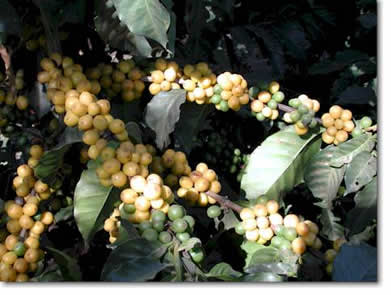|
 Arabica Coffee Bean Varietals Arabica Coffee Bean Varietals
Coffea Arabica Coffee Beans
Although
many cultivars of C. arabica exist, C. arabica cultivar
Arabica (includes var. typica) and C. arabica var. bourbon
(Named from the island of Bourbon where it was first cultivated)
are considered to be the first coffee varietals. Other varietals are believed to be a product of these two cultivars.
Production and resistance generally
governs the type of coffee beans that a farm will choose to plant.
Coffee quality is a secondary factor most of the time.
Coffee Bean Types
Typica - This
is the base from which many coffee varietals have been developed.
Like the other Coffea Arabica varietals that have been developed
from it, Typica coffee plants have a conical shape with a main vertical
trunk and secondary verticals that grow at a slight slant.
Typica is a tall plant reaching 3.5-4 m in height. The
lateral branches form 50-70° angles with the vertical stem.
Typica coffee has a very low production, but has an excellent cup
quality.
Bourbon - Bourbon coffee plants produce 20-30% more coffee than Typica, but have a smaller harvest than less
most coffee varietals. Bourbon has less of a conical
shape than Typica coffee plants, but has more secondary branches.
The angles between the secondary branches and the main stem
are smaller, and the branch points on the main stem are closely
spaced. The leaves are broad and wavy on the edges. The fruit is relatively small and dense. The
cherries mature quickly and are at a risk of falling off during
high winds or rains. The best results for Bourbon coffee are
realized between 3,500-6,500 feet. Cup quality is excellent
and similar to Typica.
Caturra - Caturra is a mutation of Coffee Bourbon discovered in Brazil.
It is a mutation with high production and good quality, but
requires extensive care and fertilization. It is short
with a thick core and has many secondary branches. It
has large leaves with wavy borders similar to Coffee Bourbon.
It adapts well to almost any environment, but does best between
1,500-5,500 feet with annual precipitation between 2,500-3,500
mm. At higher altitudes quality increases, but production
decreases.
Catuai - Catuai is a high yielding coffee plant resulting from a cross between
Mundo Novo and Caturra. The plant is relatively short,
and the lateral branches form close angles with the primary
branches. The fruit does not fall off the branch easily,
which is favorable with areas with strong winds or rain.
Catuai also needs sufficient fertilization and care.
Pache
comum -
Pache comum is a mutation of Typica coffee first observed on the
farm El Brito, Santa Cruz Naranjo, Santa Rosa, Guatemala.
Many consider the cup to be smooth or flat. This coffee varietal
adapts well between 3,500-5,500 feet.
Pache
colis -
Pache colis was found in Mataquescuintla, Guatemala in a farm
consisting of Caturra and Pache comum. The coffee fruits are
very large and the leaves are roughly textured. Pache
colis provides some resistance to phoma. It has secondary
and tertiary branching, and typically grows to 0.8-1.25 m.
It adapts well to altitudes of 3,000-6,000 feet with temperatures
between 20-21°C.
Catimor - Catimor
is a cross between Timor coffee (resistant to rust) and Caturra coffee. It was created
in Portugal in 1959. Maturation is early and production
is very high with yields equal to or greater than the yield
of other commercial coffee varietals. For this reason the method
of fertilization and shade must be monitored very closely.
The Catimor T-8667 descendants are relatively small in stature,
but have large coffee fruits and seeds. The Catimor line T-5269
is strong and adapts well to lower regions between 2,000-3,000
feet with annual rainfall over 3,000 mm. T-5175 is very
productive and robust, but can have problems at either very
high or very low altitudes. At low altitudes there is
almost no difference in cup quality between Catimor and the
other commercial coffee varietals, but at elevations greater than
4,000 feet Bourbon, Caturra, and Catuai have a better cup
quality.
Kent - Kent is used
for its high yield and resistance to coffee rust.
Mundo
Novo -
Natural hybrid between Typica coffee and Bourbon coffee. The plant was first found
in Brazil. The plant is strong and resistant to disease.
Mundo Novo has a high production, but matures slightly later
than other kinds of coffee. It does well between 3,500-5,500
feet with an annual rainfall of 1,200-1,800 mm.
Maragogype - This coffee varietal is a mutation of Typica coffee and was discovered in Brazil. The Maragogype
coffee plant is large and is taller than either Bourbon or Typica.
Production is low, but the seeds are very large. Maragogype
adapts best between 2,000-2,500 feet. The cup characteristics
are highly appreciated in certain coffee markets.
Amarello - This coffee varietal, as its name indicates, produces a yellow
fruit. It is not widely planted.
Blue
mountain -
Blue mountain is a famous coffee varietal favored for its resistance to the coffee berry
disease and ability to thrive in high altitudes. It was first grown in Jamaica and is now grown in Kona, Hawaii. Blue mountain coffee,
however, cannot adapt to all climates and maintain its high
quality flavor profile.
For more information about coffee cultivars, visit Sweet Maria's or Wikipedia.
Related
Articles
Coffee
Plant
Growing
Coffee
Environmental
Conditions for Growing Coffee
Flavor
Characteristics Due to Processing
Coffee
Diseases
|


